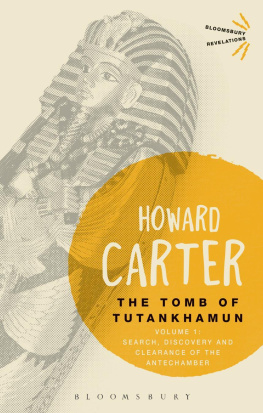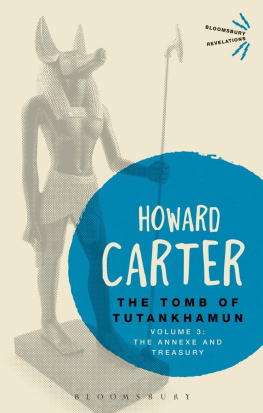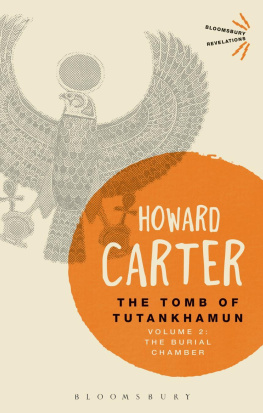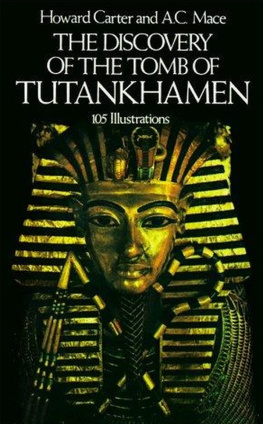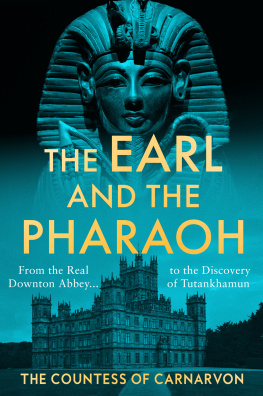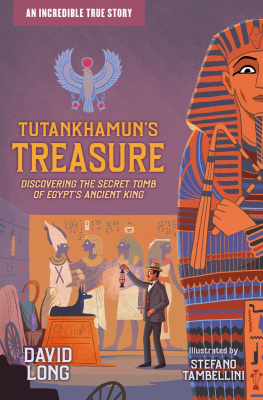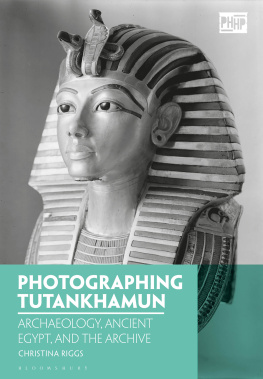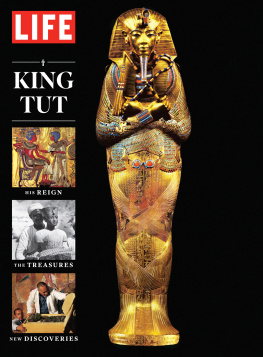The Tomb of Tutankhamun: Volume 1
TITLES IN THE BLOOMSBURY REVELATIONS SERIES
Aesthetic Theory , Theodor W. Adorno
The Oresteia , Aeschylus
Being and Event , Alain Badiou
Infinite Thought, Alain Badiou
On Religion, Karl Barth
The Language of Fashion , Roland Barthes
The Intelligence of Evil , Jean Baudrillard
Key Writings , Henri Bergson
I and Thou , Martin Buber
The Tomb of Tutankhamun: Volume 2 , Howard Carter
The Tomb of Tutankhamun: Volume 3 , Howard Carter
In Defence of Politics , Bernard Crick
Intensive Science and Virtual Philosophy , Manuel DeLanda
Cinema I , Gilles Deleuze
Cinema II , Gilles Deleuze
Difference and Repetition , Gilles Deleuze
A Thousand Plateaus , Gilles Deleuze and Flix Guattari
Anti-Oedipus , Gilles Deleuze and Flix Guattari
Origins of Analytical Philosophy , Michael Dummett
Taking Rights Seriously , Ronald Dworkin
Discourse on Free Will , Desiderius Erasmus and Martin Luther
The Theatre of the Absurd , Martin Esslin
Education for Critical Consciousness , Paulo Freire
Pedagogy of Hope , Paulo Freire
Marxs Concept of Man , Erich Fromm and Karl Marx
To Have or To Be? , Erich Fromm
Truth and Method , Hans Georg Gadamer
All Men Are Brothers , Mohandas K. Gandhi
Violence and the Sacred , Ren Girard
Among the Dead Cities , A. C. Grayling
Towards the Light , A. C. Grayling
The Three Ecologies , Flix Guattari
The Essence of Truth , Martin Heidegger
The Odyssey , Homer
Eclipse of Reason , Max Horkheimer
Language of the Third Reich , Victor Klemperer
Rhythmanalysis , Henri Lefebvre
After Virtue , Alasdair MacIntyre
Time for Revolution, Antonio Negri
Apologia Pro Vita Sua, John Henry Newman
The Politics of Aesthetics , Jacques Rancire
Course in General Linguistics , Ferdinand de Saussure
An Actor Prepares , Constantin Stanislavski
Building A Character , Constantin Stanislavski
Creating A Role , Constantin Stanislavski
Interrogating the Real , Slavoj iek
The Universal Exception, Slavoj iek
Some titles are not available in North America.
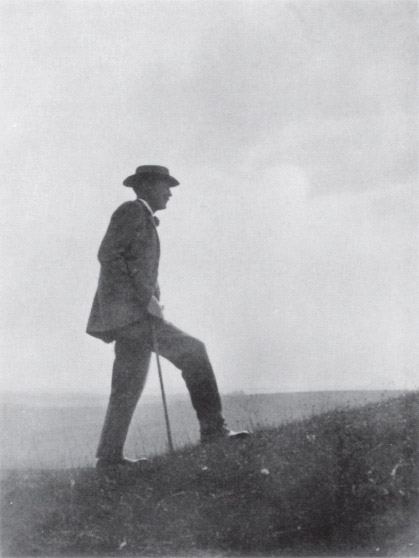
THE LATE EARL OF CARNARVON.
From a Photograph by F.J. Mortimer, FRPS
The Tomb of Tutankhamun: Volume 1
Search, Discovery and Clearance of the Antechamber
Discovered by the late Earl of Carnarvon and Howard Carter
By Howard Carter and A.C. Mace

Bloomsbury Academic
An imprint of Bloomsbury Publishing Plc
| 50 Bedford Square | 1385 Broadway |
| London | New York |
| WC1B 3DP | NY 10018 |
| UK | USA |
www.bloomsbury.com
Bloomsbury is a registered trade mark of Bloomsbury Publishing Plc
First published in 1923, by Cassell & Company Ltd. Reprinted in 2003 by permission of The Griffith Institute, Oxford.
1923, 2014 Howard Carter
Foreword 2003, 2014 Nicholas Reeves
Illustrations from Photographs by Harry Burton.
Publishers Note
The publishers wish to record their thanks to the French Ministry of Culture for a grant towards the cost of translation.
All rights reserved. No part of this publication may be reproduced or transmitted in any form or by any means, electronic or mechanical, including photocopying, recording, or any information storage or retrieval system, without prior permission in writing from the publishers.
No responsibility for loss caused to any individual or organization acting on or refraining from action as a result of the material in this publication can be accepted by Bloomsbury or the author.
British Library Cataloguing-in-Publication Data
A catalogue record for this book is available from the British Library.
ePub ISBN: 978-1-47257-687-3
Library of Congress Cataloging-in-Publication Data
A catalogue record for this book is available from the Library of Congress.
Typeset by Deanta Global Publishing Services, Chennai, India
On 4 November 1922, Howard Carter and his sponsor, the fifth Earl of Carnarvon, made a discovery in Egypts Valley of the Kings which would change the face of archaeology for good. For the first time in recorded history, diggers had stumbled upon the virtually intact burial of an Egyptian pharaohthe boy-king Tutankhamun, son and successor of the heretic Akhenaten; and it was a tomb piled high with funerary treasures and gold. The popular perception of Egyptology changed overnight: no longer the worthy pursuit of dusty academics, it was now seen as high-stakes adventure. Without the excitement engendered by Tutankhamun, it is doubtful that Indiana Jones would ever have been born.
The story of the find reads like a fairytale fiction: how Carter dug for years with little success in pursuit of the impossible dream; how, in his final season, the tomb he sought was found; how this tomb impacted upon the world, turning its discoverers into celebrities overnight; and how, with the unexpected death of Lord Carnarvon (supposed victim of the pharaohs curse), the triumph turned sour.
The careful documentation and clearance of Tutankhamuns tomb, and the transportation to Cairo of the objects interred there, took Howard Carter the best part of a decade, with the excavators personal narrative of the work appearing in three wonderfully written, self-contained volumes published between 1923 and 1933. This, the first of the trilogy, describes the years of frustration, the triumph of discovery, and the start of the long, breathtaking process of recording and clearance. It is an extraordinary readsupplemented, in this edition, by a significant if little-known article first published in Pearsons Magazine , no. 56, for JulyDecember 1923. Entitled The Tomb of the Bird and penned by Carter and his literary adviser, Percy White, it is the tale which inadvertently spawned the curse story (subsequently elaborated and spread, and to such impressive effect that it now dominates all popular discussions of the find) by Carters erstwhile rival, Arthur Weigall.
For all his riches, Tutankhamun was in life a relatively insignificant king, too young to impose his personality on the state he ruled and intentionally forgotten by those who came after. With the discovery of his tomb, his name was at long last made to live; today, more than three thousand years after his death, Egypts boy-king stands as a veritable icon not only of Egyptology itself, but of archaeological endeavour as a whole.
London, July 2002 | Nicholas Reeves |
A true incident connected with the discovery of the tomb of Tutankhamen
told by
Howard Carter & Percy White
So many inaccurate accounts of the incident have been circulated that I thought it worth while to publish, in conjunction with my friend, Percy White, the novelist, the following account of the death of my canary.
HOWARD CARTER
It was my great good fortune to find myself at Luxor soon after my friend, Howard Carter, discovered the tomb and, under the intense glare of the powerful light, to see the contents of the wonderful ante-chambers as they had been left by the raiding tomb-thieves 3,000 years ago. It was profoundly moving to be swept back across the immense and silent spaces of the dark centuries to feel the shock of that vanished civilisation and dark creed against our own troubled age, drifting, as it seems, on the same relentless stream to an unknown fate, and for a moment imagination was benumbed and sense of wonder blurred.
Next page
